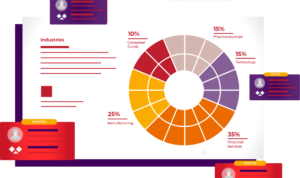Historically, the interim market has moved at a much faster pace than the executive search market. Over the past five to ten years, the client-side interviewing and overall assessment process in the HR interim market has been changing, so that the difference between the executive search process is not as apparent as it once was.
The Old Interim Model
In days gone by, it would not be unusual for the Interim Manager to take a suitcase of clothes with them to the interview and, if successful, book a room at a local hotel and start work the following day!
Our interim process would produce a shortlist in a few working days from the client’s briefing, in which time we researched the pool of available talent and shortlisted potential candidates – all possible when working with a pre-screened and select portfolio of career Interim Managers.
Following the presentation of that shortlist, there would historically be a single client interview, following which a decision would be made within a matter of hours and the chosen candidate appointed.
The Hiring Process Has Changed
This whirlwind of a process is in stark contrast to a typical HR interim recruitment process today. While our turnaround has remained thorough but fast, the client-side assessment process is frequently much more protracted. It’s not particularly unusual for there to be three of four separate client meetings and even psychometric testing for an interim role.
So why is this happening? Isn’t the purpose of Interim Management to rapidly deploy experienced, usually overqualified, senior leaders into businesses as quickly and efficiently as possible?
This more thorough and elongated interviewing and assessment process is part of a wider trend in our market, and there are four broad reasons for this apparent change in the interim recruitment process:
1. Choice
The recession flooded the interim market with new candidates. We experienced periods at Savannah when we received up to two hundred applications a week to register with us and there are undoubtedly far more candidates interested in taking on an interim assignment than, say, ten years ago.
Many redundant senior executives erroneously perceived interim management as a quick and easy way to get a paid assignment while they looked for the next permanent position. Unfortunately, the reality couldn’t be further from the truth, and landing that first senior-level interim role in HR is rarely quick or easy. Some of these individuals had little or no understanding of the key attributes of a good interim (pace, objectivity, value, efficiency) resulting in an influx of unsuitable and under-qualified candidates.
We find that many clients today are most comfortable retaining a candidate with proven experience of successfully completing interim roles; someone who has previously parachuted into a similar situation and effected lasting change quickly. However, an important caveat to this is that we do meet a number of candidates with no previous interim experience but fantastic potential, and combined with a positive attitude and commitment to an interim role, they can add real value. Either way, the pool of talent available to the client community for interim roles has got bigger.
Nigel Turner is an experienced HRD having led transformation projects for Argos, Royal Mail and Northern Rock. Nigel points to changes in regulation in the 1990’s that freed up the hiring of temporary labour, and became the catalyst for the fluidity of the interim market that we see today. As the interim market has matured and become more sophisticated, the candidate pool has grown and become more compartmentalised with specialists in each area.
Choice is a good thing, but a perception of too much choice can slow decision-making, lead to uncertainty, and require lengthier interviewing processes to separate the average from the great.
2. Risk
The flexibility of an interim solution should often mean less risk for the client. Typical notice periods are no more than a couple of weeks on either side, which historically translated into a less rigorous and quicker process than that for a permanent hire.
Again the recession changed this dynamic. As clients and individuals became more risk-averse, they frequently sought the ‘buy in’ and approval of a broad range of stakeholders throughout the organisation.
As we then moved towards a growth economy, the hiring process did not adapt with it, and today hiring decisions often involve multiple stakeholders to rubber stamp a decision.
3. Increased Expectations
David Billingham is an Interim HR and Change director who has held both board-level positions and led major change initiatives for Capita, Serco and IMI. From being both client-side and interim side, David has seen an increase in expectations about the value that an interim will bring, in terms of having the skills and experience that drives forward a change agenda and moves both the HR team and the business forward. This might be aligned to a specific transformation or turnaround project, or to leave the HR and leadership team in a better state than they found it.
“Put simply,” David says “clients now expect more from their investment in an interim and are better able to specify expected outcomes, deliverables and timescales. This, in turn, makes the selection a longer and more demanding process”.
4. Maturity of Flexible Labour Options
The UK market has been moving towards a more flexible employment model for some time – despite recent government attempts to limit the appeal of non-permanent employment. Our most recent statistics show the average length of a Savannah interim assignment to be nine months or longer, so interim is not always a short-term solution anymore.
We have also noticed an increase in requests for fixed term contracts or ‘Interim to Permanent’, essentially a ‘try before you buy’ solution. All this points to a change in mindsets. Out of work candidates are much more interested in the nature and challenges of the role rather than the contractual arrangement. Interim contracts have become longer, senior level permanent tenures shorter, and the lines have often become blurred in the minds of both clients and candidates.
Julie Smith is Managing Director of Metamize – an Executive coaching, business and HR consultancy. Julie has experience as both an Interim HRD and as a hiring manager for Interim HR positions, and has noticed a considerable increase in business-as-usual roles being advertised as interim or fixed-term contracts such as maternity cover for a year.
Julie’s advice is to differentiate between the types of interim role and then use the appropriate recruitment process. Julie says “A simple question to ask is ‘would this role normally be permanent?’. In the case of maternity cover, then yes, so apply your permanent recruitment methods if that works for you. For a short-term project, then usually it’s a no, as the day-to-day work after the project would be handed over to an employee and the interim moves on.”
What Next?
Senior HR Interim Managers need to be aware that client demands are not what they were 5-10 years ago, with more exacting recruitment processes and fierce competition for the most attractive roles. In my next article, I will look at how an HR Interim Manager should position themselves in this evolving market. In the mean time, let me know in the comments: how do you perceive recent changes in the interim market?
Special thanks to Julie Smith, Nigel Turner and David Billingham for their insight and contribution to this article.




